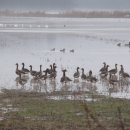About Us
Reelfoot National Wildlife Refuge was established on August 28, 1941, under the authority of the Migratory Bird Conservation Act. Subsequent lands for the refuge were acquired under the authority of the Refuge Recreation Act and the Endangered Species Act of 1973.
The refuge is located within four miles of the Mississippi River in rural northwest Tennessee, about 35 miles north of the city of Dyersburg and 15 miles southwest of Union City. It encompasses part of Lake and Obion counties in Tennessee, and extends northward into Fulton County, Kentucky.
Our Mission
Providing habitat for migratory birds, the most numerous of which are waterfowl, was the purpose for which the Reelfoot NWR was established. Thus, the refuges’ management priorities are directed toward providing quality wetlands areas that are attractive to migratory birds, including dabbling ducks, diving ducks, and geese.
Our History
The most significant recent geological event, which shaped the present-day landscape of the Reelfoot Lake area, was the New Madrid earthquakes. This series of earthquakes, which shook the area from December 1811 through February 1812, is reported as being the most significant to hit the continental United States in recorded history. These earthquakes reportedly caused the Mississippi River to flow backwards when an area just south of the Reelfoot refuge, known as the Tiptonville Dome, was thrust violently upward into the path of the river. Likewise, an area as much as 30 miles long and 10 miles wide, by some accounts, sank up to 50 feet, creating a sunken forest and forming the present-day Reelfoot Lake.
Other Facilities in this Complex
Reelfoot National Wildlife Refuge is managed as part of the West Tennessee National Wildlife Refuge Complex. There are four other refuges included in the Complex.



